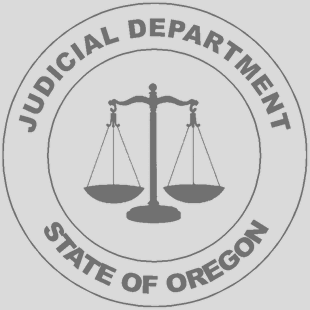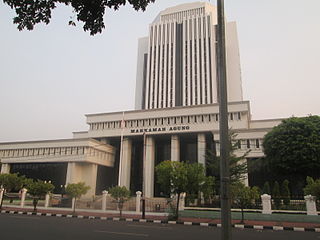Courts
Colorado courts include the:
- Colorado Supreme Court,
- Colorado Court of Appeals,
- Colorado district courts,
- Colorado county courts,
- Colorado water courts,
- and municipal courts.
All of the courts above, other than municipal courts and Denver's county court, are part of the state court system. In Denver, county courts and municipal courts are integrated and are not part of the state court system for administrative purposes, and the Denver Probate Court and the Denver Juvenile Court have jurisdiction over probate and juvenile matters, respectively. Outside Denver, these matters are within the jurisdiction of the district courts.
Supreme Court
The Colorado Supreme Court is the state supreme court, the state's highest appellate court. The Supreme Court consists of chief justice (currently Monica M. Márquez) and six associate justices.
Court of Appeals
The Colorado Court of Appeals is the state intermediate appellate court. It has jurisdiction primarily over final judgments of district courts acting as trial courts, and of approximately 33 kinds of an administrative agency or board determinations. [1] It is bypassed in the case of death penalty appeals, cases in which a lower court has declared a law or ordinance to be unconstitutional, appeals from Public Utilities Commission decisions, certain appeals related to the initiative process, appeals from water courts, interlocutory relief, and the further appeal of cases already appealed from a county or municipal court to a district court judge, all of which are appealed directly to the Colorado Supreme Court. [2] Unlike the other state courts, this court is a creature of statute and not mandated by the state constitution. There is a single geographical division of the Colorado Court of Appeals co-located in the same courthouse with the Colorado Supreme Court in Denver that handles all intermediate appellate court cases statewide. The Colorado Court of Appeals does not have any internal subject-matter divisions. It hears cases in panels of three judges, but it does not have an "en banc" review of panel decisions as the federal United States courts of appeals do.
District courts

The Colorado district courts are the state trial courts of general jurisdiction. There are 22 judicial districts in the state, which include one or more of Colorado's 64 counties. They have original jurisdiction in civil cases with any amount in controversy; felony criminal cases, domestic relations, family law, and cases involving minor cases (including adoption, dependency, juvenile delinquency, and paternity actions), probate, and mental health cases. Court filings in district court generally indicate the county within the district in which the action is filed and the district court generally conducts proceedings in that action in that county.
County courts
Colorado county courts are courts of limited jurisdiction. There is one county court in each of the 64 counties, including the consolidated city-counties of Denver and Broomfield. They hear misdemeanour cases, preliminary hearings in felony cases, evictions, civil cases not involving ownership of real property with an amount in controversy up to $25,000, and several other narrowly defined types of cases such as name changes and temporary restraining orders.
Municipal courts

In some municipalities of Colorado, there are municipal courts, which are not part of the state court system. Municipal court jurisdiction is limited to municipal ordinance cases, including traffic violations imposed under municipal ordinances rather than state statutes, which have maximum penalties similar to those of state law petty offences. [3] These courts have no statutory jurisdiction over other classes of cases, [4] although municipal courts do have inherent procedural powers associated with their status as a court, such as contempt of court powers and powers related to the calling and compensation of jurors. [5] Some municipal courts are courts of record that can impose greater sanctions for ordinance violations and are subject to appellate review like state courts. Other municipal courts are courts not of record, which can impose only less severe sanctions for ordinance violations, whose decisions are appealed through trials de novo in the appellate court. A small number of municipal courts in Colorado have been granted civil jurisdiction in certain ordinance cases, such as cases involving land use, under municipal home rule powers, in addition to quasi-criminal jurisdiction.
Water courts
The state's seven Colorado water courts have exclusive subject-matter jurisdiction over adjudications of water rights. Established in 1969, there are seven water courts in each of Colorado's seven major river basins: South Platte, Arkansas, Rio Grande, Gunnison, Colorado, White, and San Juan. Water courts are presided over by district court judges who have simultaneously been given responsibility for water court cases in each of the state's seven drainage basins. The water courts are divisions of the district courts in that basin and use the district court's accessories, and water judges are districted court judges appointed by the Colorado Supreme Court.
Other tribunals
Colorado's state government also has several executive branch administrative law courts and independent tribunals outside the judicial branch. Some of the most notable of these are the administrative law judges handling election law violations in the Colorado Secretary of State's office, the Public Utilities Commission when it acts in a quasi-judicial manner, unemployment-insurance hearing officers, administrative law judges handling motor vehicle license revocations, quasi-judicial municipal land use boards, professional regulatory boards, and an Independent Ethics Commission. [6] The Colorado Office of Administrative Courts is Colorado's centralized administrative court system, whose administrative law judges decides workers' compensation, human services, licensing, and a variety of other cases. [7]









